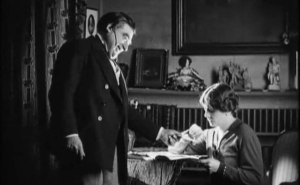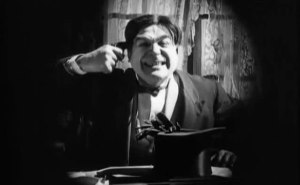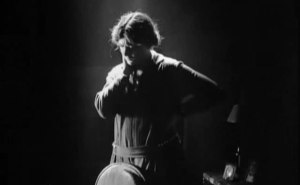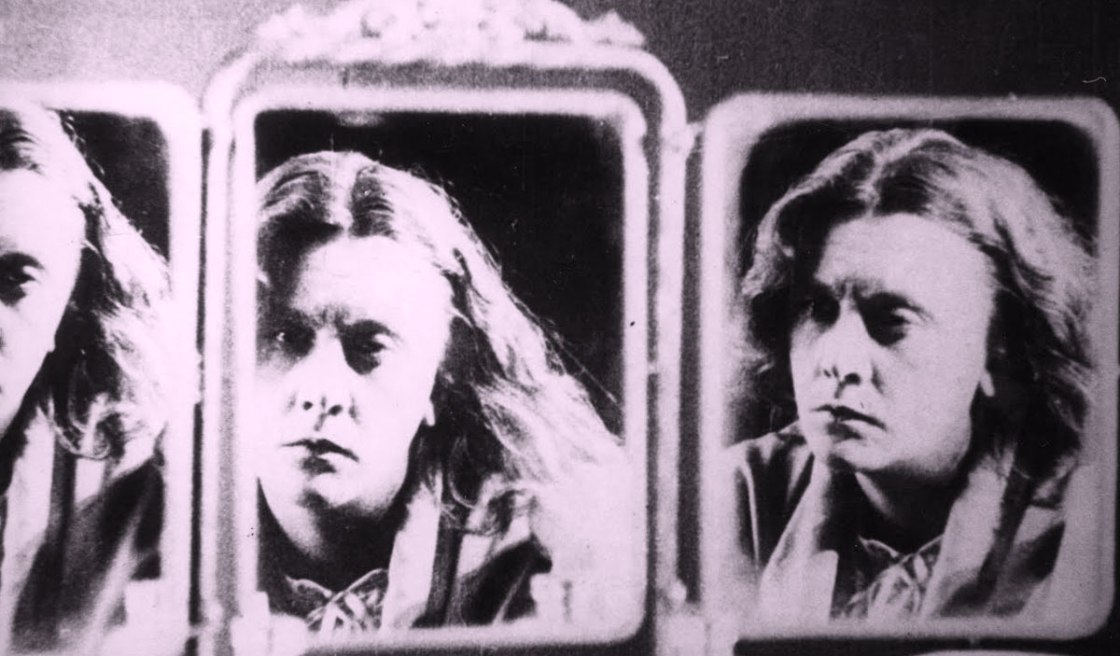Germaine Dulac examines the thoughts, dreams and homicidal tendencies of a woman trapped in a marriage with a buffoon. Gorgeously shot and imaginatively directed, this is a must-see.
This review is part of the Early Women Filmmakers Blogathon, hosted by me and sponsored by Flicker Alley. Be sure to read the other posts!
We’re not smiling
Germaine Dulac is often described as an impressionist, surrealist or avant-garde filmmaker but don’t let that scare you away from The Smiling Madame Beudet; the film is perfectly accessible to all and is considerably more fun than, say, Jean Epstein’s work. Contrariwise, fans of the impressionists will find plenty of depth and symbolism to chew on. Come on in, the water’s fine! (In any case, we should have learned our lesson from the mad dash to declare all German silent films Expressionist: labeling can help organize but it can also be limiting and simplistic.)
For what it’s worth, The Smiling Madame Beudet is usually put in the impressionism box. And that’s all we’re going to say about that.

Madame Beudet (Germaine Dermoz) is married to a well-to-do fabric merchant (Alexandre Arquillière). While she wants to read magazines and play the piano, he wants to drag her out to the opera and won’t take no for an answer. It has been said that contempt is one of the emotions from which a relationship cannot recover and we soon see the source of it for Madame Beudet. Her husband behaves like a toddler, raging and screaming when he does not get his way.

Besides this, the Beudots have nothing in common. She like Debussy, he likes Gounod. She wants quiet, he thrives on noise. The worst, though, is Monsieur Beudet’s idea of humor. He thinks it’s jolly good fun to hold a pistol to his own head and threaten to fire when he is frustrated. His wife has seen this trick too many times; it is clear that Monsieur Beudet has no intention at all of killing himself as the pistol is never loaded.
There are few things more loathsome than a suicide parody. Having dealt with someone who employed it to get a rise out of people (and then laughed at their concern), I can assure you that this act quickly kills any affection one might feel for the trickster. Such is the case for Madame Beudet.

After her husband has left for the opera (and locked her piano on his way out), she lets out the anger that she has been holding inside. In a moment of rage, she takes her husband’s pistol from the drawer and loads it with live ammunition. His next suicide hoax will be his last.
Well, that escalated quickly.
Dulac’s beautiful use of light shadow and special effects has been praised in all corners and rightly so but she also coaxes a beautiful performance out of Dermoz. Before Monsieur Beudet even enters the scene, we can see that there is something deeply wrong with their marriage. Madame Beudet is listless, resentful and the only time she manages positive emotion is when she opens a magazine. It is full of fodder for her imagination: cars, handsome men, beautiful clothes. The opposite of her obnoxious husband.

This has been called one of the first feminist films (hi, Wikipedia) but I think that’s overstating the case. Margaret Sanger made a 1917 birth control film—called, shockingly enough, Birth Control— for a start. (Yes, I realize she considered it a free speech issue but the fact stands that it was free speech about contraception advice, something that overwhelmingly affected women.) I would also mention that The Smiling Madame Beudet contains similar themes to William de Mille’s brilliant Miss Lulu Bett, including a crude husband who uses “humor” to bully his family. Viewers interested seeing a woman stand up for herself and leave an emotionally abusive marriage should also check out Sawdust and Salome (1914). Long story short: don’t do your research on Wikipedia.

In any case, not being the first is hardly a reason to dismiss the picture. In fact, I would argue that this obsession with chronology distracts us from more important matters. For example, let’s talk about the way the protagonist is portrayed.
The film constantly lets us into the inner world of Madame Beudet thanks to daydreams, visions, dreams and general access to her imagination. When her husband is engaging in one of his tantrums, she imagines driving away in her own motor car or a huge athlete carrying away her obnoxious spouse. When he finally leaves her alone for the evening, she imagines him returning through an open window, cackling all the time. We are shown some of Monsieur Beudet’s thoughts as well but they are mainly confined to the shapely ankles of an opera singer. An unequal marriage indeed.

Dulac also uses more mundane props to illustrate the conflict in the marriage. There is a vase of flowers on a small table. Madame Beudet prefers it to the side and Monsieur prefers it in the center. The pair drag the vase back and forth throughout the course of the film until the argument is finally settled in an unexpected way.
By the way, Beudet’s business partner is in the opposite situation, a gentle and mild man married to a raging, bullying oaf of a wife. In a Hollywood film, they would have found a censor-pleasing way to swap spouses but there is no such easy solution here. There’s a gun a la Chekhov in the drawer and it’s going to be fired before the curtain can fall on this marriage.

Without giving away too much, the finale of the film could be interpreted as happy but only by the most literal-minded of viewers. The clues are all there: any happiness will not last, if it ever existed at all. According to Germaine Dulac: A Cinema of Sensations by Tami Williams, Dulac originally included a shot of young spectators applauding the “happy” ending. Such sarcasm was not appreciated and the scene is not present in most prints. Well, in all fairness, it is rude to mock one’s audience to their faces.

The Smiling Madame Beudet is an intelligent and beautiful examination of a marriage that is experiencing its death rattle. The extreme sympathy with which Dulac treats her title character and the clever way we are shown her inner world are two reasons why the film plays very well for modern audiences. It comes highly recommended.
Where can I see it?
The Smiling Madame Beudet will be included in the Early Women Filmmakers box set from Flicker Alley.
***
Like what you’re reading? Please consider sponsoring me on Patreon. All patrons will get early previews of upcoming features, exclusive polls and other goodies.

This sounds fascinating, and the fact that Dulac shows Madame Beudet’s inner life through daydreams and other imaginings really intrigues me, because I always enjoy that sort of thing. Thanks for recommending this!
It’s really excellent, I hope you enjoy it. 🙂
Champing at the bit for Flicker Alley May 9th release date to arrive, and even more so after reading this review. Ordered two more copies of Early Women Filmmakers as 2017 gifts for friends because, after racking my brain for something to get two special people for their birthdays, reading all the wonderful Blogathon reviews decided it!
Yay! I’m looking forward to it too and I’m sure your friends will love it. 😀
in love with this silent movie! Thank for sharing!
My pleasure! 🙂
I look forward to seeing this one after reading about it here. It sounds absolutely fascinating!
Yes, it’s excellent!
Hi Fritzi. That was a nice essay. I want to see the movie. When I see a title like that, I always stop to wonder if it is sarcastic or ironic. Sounds as if it was this time.
Yes, I would definitely say so in this case. It’s a splendid little film, so glad to have finally seen it.